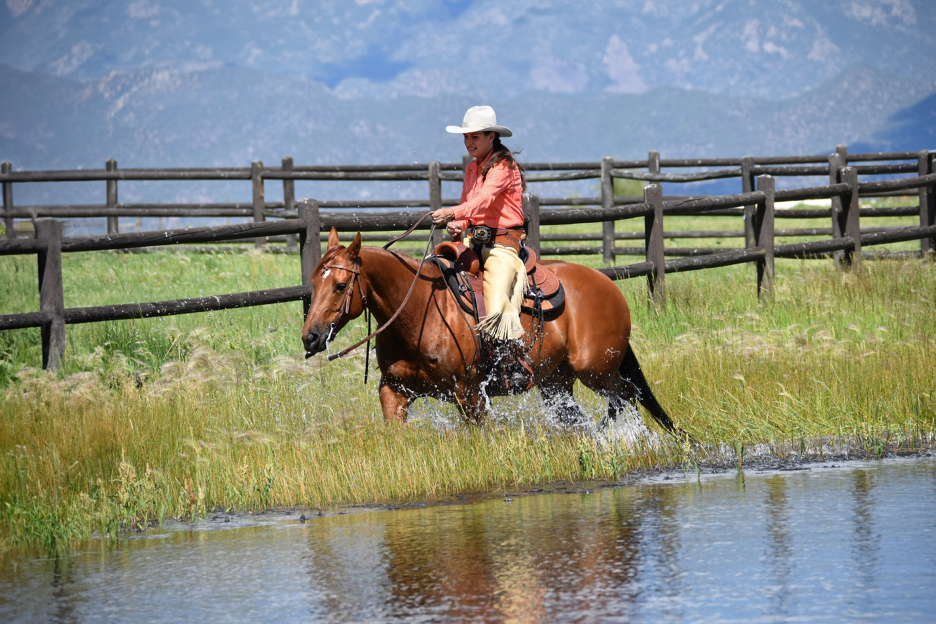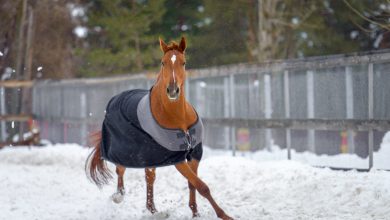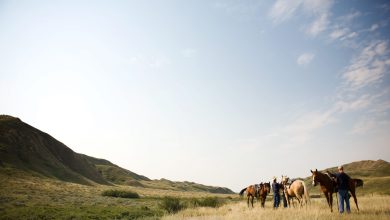
This article is brought to you by Cosequin® Joint Health Supplement.
On the trail, you never know what Mother Nature’s going to throw your way. Water crossings are a commonly faced obstacle, and knowing how to guide your horse through those watery spots isn’t just a cool skill to have; it’s a necessity to keep the ride both fun and safe. Whether you’re facing a little babbling brook, a shallow stream, or a full-blown river, mastering the art of water crossing is a must.
Crossing water doesn’t have to be a dramatic affair. In fact, it’s a perfectly natural thing for your horse to do. Wild horses cross water all the time with the herd. Although your horse might be unfamiliar with crossing open water, with some simple prep before you hit the trail, you can prepare your horse to cross water like a pro. Let’s first break down some do’s and don’ts that I recommend rider’s follow when navigating a water crossing on the trail.

The Don’ts
Don’t Jump It
I often see riders allow their horses to leap across a stream, ditch, or narrow water crossing. Although this seems like a fun time, it can definitely be hazardous. Although there is a time and a place to jump a ditch or obstacle, crossing water should usually be done in a slow, and deliberate manner. A horse that leaps across a ditch may very well be exhibiting flight behavior. His instincts kick in, and he tries to get across the water as quickly as possible. However, you and your horse don’t know for sure what is on the other side of the water. Is the footing safe and stable? Is there a depression in the ground where he could trip?
This is especially problematic if you aren’t expecting your horse to jump the water obstacle. First, you can be thrown off balance if caught by surprise. Second, your horse is exhibiting disobedient behavior and making unauthorized decisions that could put you both at risk.
Don’t Let Him Rush
Similarly to rocking back on his haunches and over-jumping the water, rushing through it is also problematic. This is common in horses that are inexperienced at crossing water and want to get it over with as fast as possible. Again, he’s making decisions based on fear or the flight response, and this can put you both in a bad spot. Read on to learn how to counteract this behavior.
Don’t Let Him Paw at the Water
I see this often. A rider stops in the water to let their horse take a drink, and the horse begins to paw and splash at the water. Although this behavior looks cute, he’s most likely prepping to roll. By pawing at the water, he can judge the depth to see if it’s safe to roll. Stop this behavior as soon as it starts, by asking him to pick his head up right away.

The Do’s
Take Your Time
Ideally, we want our trail horse to put his head down and navigate his way through water in a deliberate and forward motion without rushing through it. Since many horses will try and rush through water when inexperienced, it’s up to us to teach this ideal behavior. Further in the article I will break down some simple steps to teach the desired water crossing behavior.
Determine Your Desired Drinking Behavior
Whether you want your horse to drink every time you cross water, or you want him to only drink at designated spots, be clear with your expectations. Some riders want their horses to drink every time water is available, which can be easily trained. If you don’t want him to drink at a certain spot, ask him to pick his head up and keep moving if he begins to drop his head. Whatever you decide, make it clear to your horse from the beginning when teaching desirable water crossing behavior.
Steps to Teach Safe Water Crossing Habits
Start Slow
Begin by starting at a water crossing similar to something you’d find on the trail. Ask him to step forward but stop him before he becomes reactive. This might be the point where you feel him prepare to leap or rush across the water. As he stands still, praise him, and let him stand in place quietly. Loosen the reins so he relaxes and lowers his head more. Sit there for about 30 seconds. Ask him to take a few more steps, stop and praise, sit still, and continue to repeat this pattern until he steps into the water.
Ease the Anxiety
If your horse is struggling to stand still and exhibiting signs of anxiety, it might be time for some groundwork. Don’t be afraid to dismount, in a safe area, and ask him to move his feet. Or practice standing still for longer than 30 seconds if this is something he is struggling with. Asking him to stand in that spot for even 10-15 minutes, in a calm and relaxed posture, can help him learn that standing quietly is alright, and he is safe.
Control His Steps
A horse that jumps across water is making decisions on his own and is not entirely within your control. When introducing water crossings, practice controlling exactly how many steps you want your horse to take. Here, you are establishing that you’re leading the way and setting the pace.
Mix it Up
Practice these steps in different areas. Each water obstacle you come across will be unique and challenging in some way. Practice going up and down water crossings with embankments, navigating different water depths (safely), and focus on controlling his speed.
[Prep Your Gear with Julie] [Hit the Road with Julie’s Top Tips] [Learn to Tie Safely from Julie] [Master Julie’s De-Spooking Process]Trainer and clinician Julie Goodnight, Poncha Springs, Colorado,hosts RFD-TV’s, Horse Master. Her book Goodnight’s Guide to Great Trail Riding is available at EquineNetworkStore.com. Learn more about Julie’s program and training methods at juliegoodnight.com.



